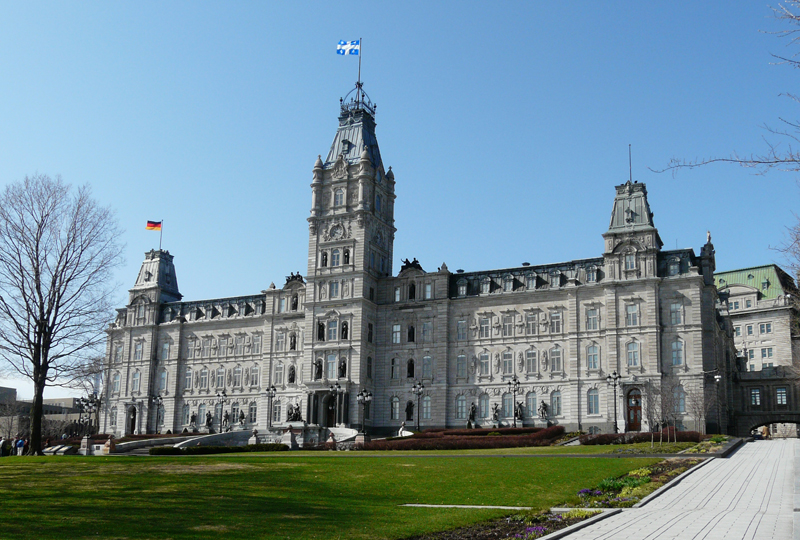Parliament of Quebec and National Assembly, a place of power and memory

The National Assembly of Quebec is the only democratic assembly in North America where the majority of elected representatives are Francophone. The 125 elected members that make up the Assembly meet in the Parliament building in Quebec City, where they vote on laws and budgets, participate in debate and make decisions that guide the future of Quebec. This magnificent and prestigious building, inaugurated in 1886, is the work of architect Eugène-Étienne Taché. He was inspired by the Second Empire style then in vogue in France, to attest to the historical ties between Quebec and the mother country. Taché wanted to illustrate the amalgam of Indigenous, French and British elements at the origin of Quebec society by decorating the façade with some 30 sculptures of historical figures. Parliament Hill provides a setting for the National Assembly, which can be visited with the help of accredited guides.
To learn more…
The historical heritage of Quebec Parliament
The National Assembly has been a National Historic and Heritage Site of Quebec since 1985. It is the principal place for commemorating Quebec’s history. Architect Taché’s initial idea evolved over time and spread to Parliament Hill, which now displays several statues of male and female politicians of the 20th century. The Promenade des Premiers-Ministres pays homage to Quebec’s heads of state, and gardens showcase Quebec’s plant heritage on the lawn facing Parliament. TheCommission de la capitale nationale du Québec is responsible for maintaining and beautifying the site.
At the outset, Taché announced his plan to have the phrase “Je me souviens” [I remember] carved above the main entrance to the building, which became the Province of Quebec’s motto in 1939. Taché also wanted to pay homage to the diversity of the people who had shaped Quebec’s history by erecting statues in niches on pedestals in the façade, complemented by coats of arms of influential individuals sculpted in the stone. He also dedicated two large sculptures to the First Nations who had welcomed the European immigrants to their territory. He gave pride of place to the pioneers of New France: Marie de l’Incarnation, Champlain, Marquette, Frontenac, Talon and others, as well as their successors: La Vérendrye, Montcalm, Salaberry, and son, while also pointing out the role of the British: Wolfe, Dorchester and Baldwin. Parliament’s façade thus illustrates the history of the community that elects the representatives who sit on its behalf.
An architectural masterpiece
Taché produced a masterpiece in designing Parliament, where the balance of volumes and abundant ornamentation of the façade lend harmony and dignity to the building, qualities that are perfectly suited to its function. The French had found the Second Empire style, inspired by the Renaissance, particularly pleasing following the expansion of the Louvre in the 1850s. When Taché adopted it, he was very much an innovator in Quebec.
The building is square in shape. Its four wings, each four storeys high, surround a closed interior court. The central wing is surmounted by an eight-storey clock tower. The mansard roofs are pierced with skylights, and the central projections are topped with rectangular domes. A fountain surrounded by a monumental semi-circular staircase leads up to the entrance. The sidings of worked stone give texture and life to this imposing building.
Visiting Parliament
Accredited guides lead visitors up a central staircase to the two main halls of the National Assembly, the Salon Bleu, where parliamentarians sit, and the Salon Rouge, the former hall of the Conseil législatif (the equivalent of Canada’s Senate)—abolished in 1968—where awards ceremonies are now held. Several works of art, stained glass windows, various objects and portraits of all the premiers of Quebec embellish these halls and corridors, in particular a large painting by Charles Huot, Le débat sur les langues, which represents a session of the Parliament of Lower Canada, held in 1793, where it was decided that French would be welcome in Parliament even though it had initially been forbidden.
Free tours for the general public and school children shed light on how the Canadian democratic system works and on the parliamentary history of Quebec.
The democratic heritage of Quebec
The Constitutional Act of 1791 implemented the British parliamentary system in Lower Canada (present-day Quebec). The first elected deliberative assembly sat in 1792, making Quebec a pioneer of democracy in the world. Parliament was then located on the summit of Cap-Diamant, in today’s Montmorency Park. A violent fire that reduced the building to ashes in April 1883 put an end to nearly a century of parliamentary life in that place. Fortunately, the construction of the new Parliament of the Province of Quebec—one of the four founding provinces of Canada in 1867—was sufficiently advanced to be able to accommodate the members of Parliament. The official inauguration took place in April 1886.
In the early 20th century, the offices of the Parliament building became insufficient to contain the growing machinery of government. Between 1910 and 1937, four buildings were constructed on Parliament Hill, to the west and north of Parliament, to house the library and various ministries. The next expansion phase started in the 1960s, with the construction of buildings G, H and J, built in the contemporary style a short distance away, but outside the confines of Parliament Hill, thus preserving the architectural unity of the whole.





